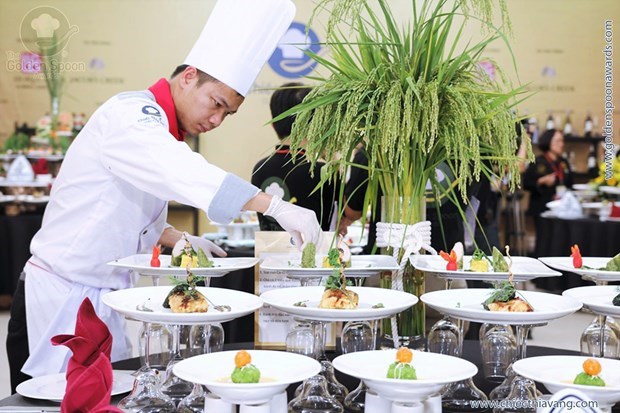
Chef Hoang Van Lien was decorating party table in Northern semi-final round.
1. Once again we saw featured
plants and ingredients of Vietnam, especially highland’s specialties, which
were introduced by Team no. 81 at the semi-final round of The Golden Spoon
2016. Chef Hoang Van Lien has been longing for a new style of Vietnamese
cuisine and he performed it in this semi-final round. His team developed and
connected the ideas from exotic highland specialties to familiar plain food,
and finally to Ha Noi capital – where many different culinary cultures gather
to be crystalized to famous specialties.
Every
dish, as chef Hoang Van Lien explained, has shown the fate of their career and
the passion to our nation even though originally it was just a dish they had
tasted once and been impressed. Attending in The Golden Spoon Contest 2016 the
first time but going straight to the semi-final round, chef Hoang Van Lien and
his colleagues La Thi Thuy and Hoang Thi Ngoc Anh must double their effort to
compete other experienced teams. They arrived in HCMC one day earlier to
research and prepare for what was coming next. They were so ready to dance and
hash with their ingredients.
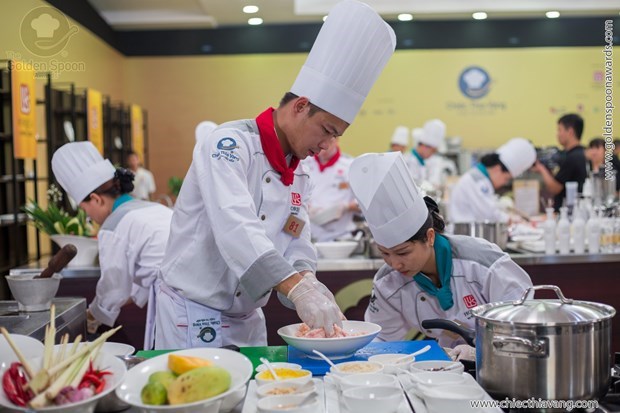
Team no.81 chefs made effort in each progressing step.
Catching
an impressive scent from the big boiling pot in Team no. 81’s kitchen, Food
Arisan – judge Bui Thi Suong had to stop to define the dish. Judge Bui Thi
Suong asked “Is that Doi seeds?” and
chef Hoang Van Lien confirmed it while chopping spice leaves. Chef Hoang Van
Lien opened the lid and an ambrosial scent filled up the air.
When
other judges coming to Team no. 81’s kiosk, chef Hoang Van Lien proudly
presented this unique dish – boiled local pork with wild leaves
in cham cheo sauce, Don leaves salad and Seng Cu rice cooked with fresh turmeric.
Not only using famous local specialty black pork, they also brought in many
regional fruits and spices, such as Mac
Mat leaves and fruits, Doi seeds,
apples and pears from Sapa, Nep
leaves, lemongrass, and galangal. Chefs boiled a big pot with spices and
vegetables in 30 minutes to extract oil and savor then added pork (cleaned and
heated on fire) into the pot to absorb all the essence from the broth. Just a
bite, the pork burst a fruity yet robust taste on your tongue.
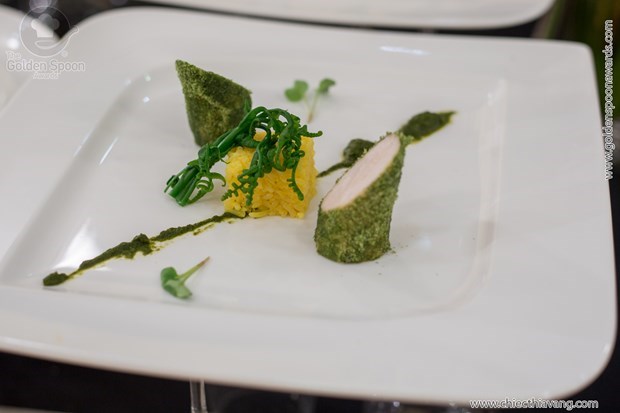
Boiled local pork with wild leaves in cham cheo sauce, Don leaves salad and Seng Cu rice cooked with fresh turmeric.
An indispensable seasoning going
along with pork is cham cheo. In Thai
minority’s language, “cham” means dipping and “cheo” is an adjective, which
describes the aroma of combined spices. There are 3 – 4 types of cham cheo, depending on main dishes. Cham cheo for this pork was made from
grilled green peppers, garlic, Mac Khen seeds, salt, MSG, spicy leaves, and a
teaspoon of lime juice. A bite of pork dipped in cham cheo and a bowl of Seng
Cu recalls all memorable images of highland hometown.
2. Chef Hoang van Lien said that the
dish of highland pork was a continuation and an upgraded idea of hometown
dishes from last round, which was sautéed duck breast with Doi seeds in fruit sauce. Breast flesh was from a good-size duck (3kgs)
then marinated with salt, black pepper, and Doi
seeds. After 30 minutes, sauté duck breast and squeeze fat out of the flesh.
Bake duck breast about 7 minutes at 160oC till it gets tender but still pinky.
The thicken sauce was made from mango flesh grounded with fresh orange juice
then boiled with Doi seeds and
seasonings. These 2 dishes’ ingredients were acquainted and totally from their
region but they all showed intense creativities for Vietnamese cuisine of Muong
Thanh Lao Cai hotel’s chefs.
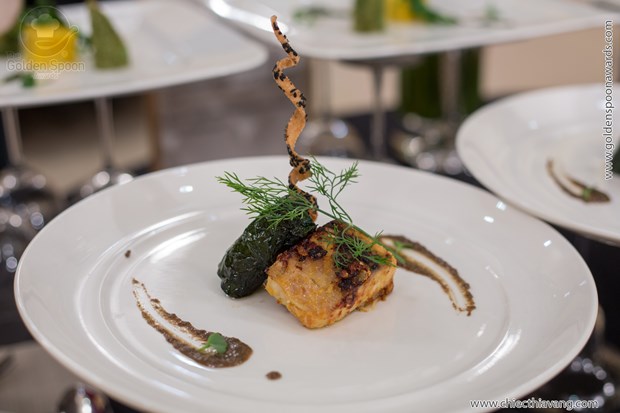
Two types of traditional Fish paste served with fresh vegetable, Ke sesame rice cake, and shrimp paste with lime juice.
With the same creative line, semi-final
round’s Golden Dishes of Team no. 81 also included Ca Ra crabs with water spinach soup, two types of traditional Fish
paste served with fresh vegetable + Ke sesame rice cake + shrimp paste with
lime juice, and sweet rice balls stuffed mung bean, covered in Com (flatten young sweet rice), and
served with Ngu banana sauce and fresh coconut. Chef Hoang Van Lien presented “Fish paste was originated by Doan family in
Ha Noi since French colonial period then famously spread out all over the
north. To make Fish paste, they often use catfish family, such as Nheo (Siluridae),
Nganh (Cranoglanis sinensis), Lang (Hemibagrus),
Tre (Clariidae), and sturgeon because they’re all
highly nutritious, fat, flavorful, and not bony.
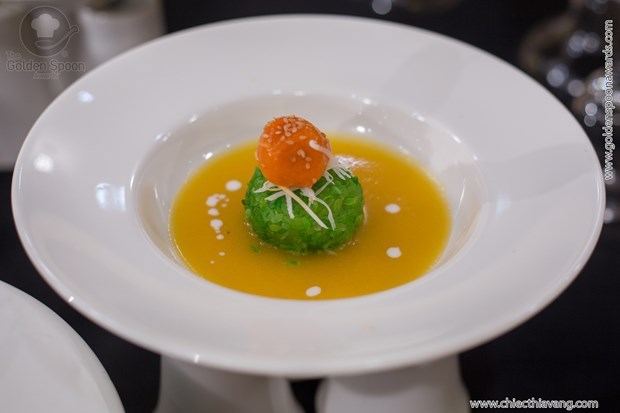
Sweet-rice balls stuffed mung bean, covered in Com, served with Ngu banana sauce and fresh coconut.
Sweet-rice balls were made by soaking sweet-rice with a
small amount of regular rice in cold water about 8 hours, smoothly grinding
then draining out. Final dough was shaped into balls, stuffed with a piece of
sugar, and boiled to cooked. This dessert was used to have during Hanshi
Festival (3rd March in Lunar calendar) but today it has
become more popular. Com (flatten young rice) in Vong village, Ha Noi city, is a
famous product all over Viet Nam. Best young grains are chosen from Red river
delta area, pestled then wrapped by fresh lotus leaves to become a featured product.
People have Com and banana together, make Cha Com (pork paste with Com), or
just simply have it as a snack with a cup of tea. Those are really Hanoi!”
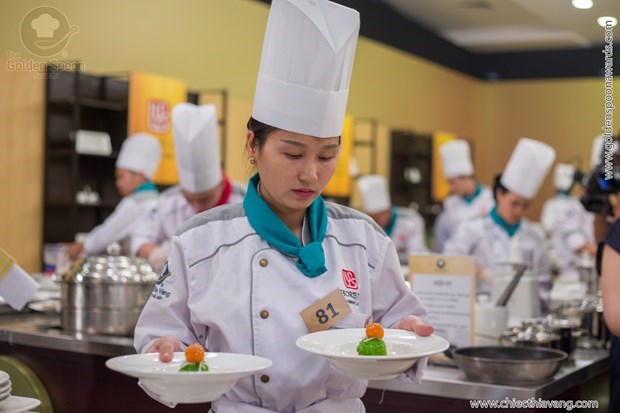
Highland female chef was ingenuity bringing her dish to party table.
Those were impressive dishes but the
significantly unique one must be Ca
Ra crab with water spinach (Ipomoea
aquatic). Ca Ra is a wild river crab and it has several different names.
They look like fresh-water crabs with 2 hairy claws and naturally live around rocky
areas in northern river system. Their peak season is from September to October,
when they are so meaty and flavorful. This time, Ca Ra crabs were cooked with
the most common vegetable in Vietnam – water spinach.
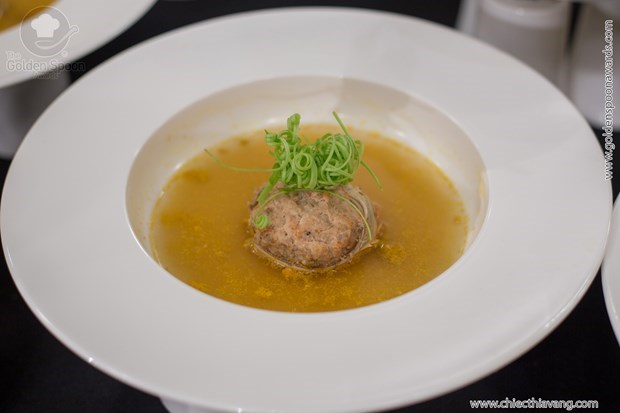
Ca Ra crab soup with water spinach.
It
did not take lots of work for the dish. First, Ca Ra crabs would be smashed,
filtered then boiled to collect “gach” (the protein agglutinating together).
This plague was well mixed with smashed black tiger prawn, pork paste, and a
handful pepper and Welsh onions. This paste was stuffed back into crab shells,
boiled in a pot until cooked then added chopped water spinach in. Tips of the
dish, according to chef Hoang Van Lien, are “To have a qualified soup, crabs must be smashed, not grinded, to reduce
unnecessary work and to avoid color contaminating into the broth. The perfect
soup has to have sweet taste from crabmeat and scented buttery taste of “gach”.
This soup is a nutritious, rustic yet feature dish of Vietnamese countryside.”

The menu helped Muong Thanh Lao Cai Hotel to seize a ticket to final round.
Professional
judge Bui Thi Suong identified that although Team no. 81 performed all
old-fashioned food, they put a lot of work into refreshing and renewing their
dishes. In particular, the Ca Ra soup, Mrs. Suong said “very flavorful broth but still can be purified a little bit more to
make it excellent”. Fish paste retained all natural flavors. Mrs. Suong
especially liked the dish of boiled pork and she commented, “Pork is firm, balmy, and tasty. The broth is
ambrosial with Doi seeds, Mac Mat and fruity. Pork is absorbed all these
special flavors and scents. Such an impressive dish!”
By The Golden Spoon Award